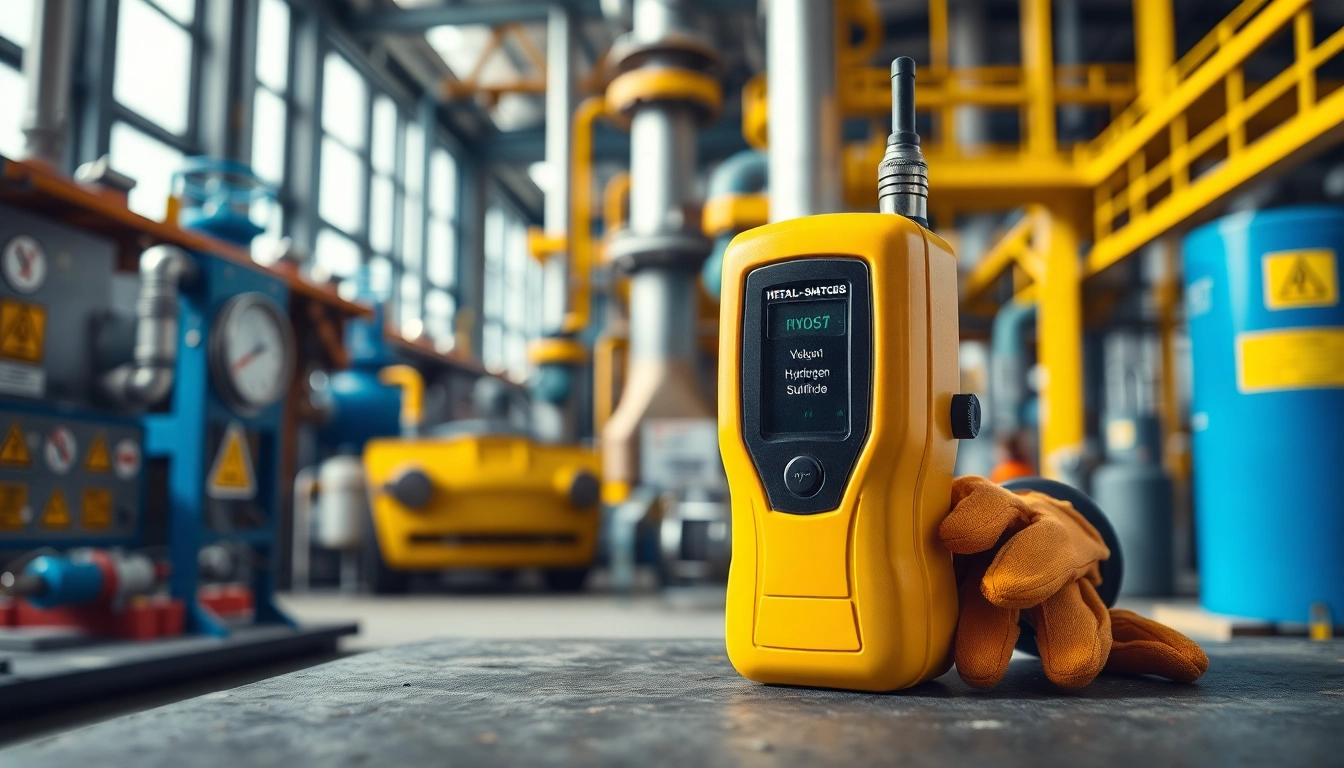Understanding Hydrogen Sulfide Gas
What is Hydrogen Sulfide?
Hydrogen sulfide (H2S) is a colorless gas known for its distinct odor of rotten eggs. It occurs naturally in crude petroleum, natural gas, and volcanic gases. This toxic gas is produced by the microbial breakdown of organic matter, making it commonly found in sewers, swamps, and areas with decaying vegetation. Due to its high toxicity and flammability, understanding H2S is crucial for safety in various industries, particularly those involving oil and gas extraction, wastewater treatment, and paper manufacturing. Detection and monitoring of hydrogen sulfide is essential to prevent exposure and ensure workplace safety.
Health Risks and Safety Hazards
Hydrogen sulfide is not only irritating but can also be life-threatening at higher concentrations. The Occupational Safety and Health Administration (OSHA) has established permissible exposure limits for H2S, which emphasize the importance of having monitoring systems in place. Short-term exposure can lead to symptoms such as irritation of the eyes and respiratory system, headaches, and dizziness; however, prolonged exposure or higher concentrations can result in loss of consciousness or even death.
Additionally, hydrogen sulfide can contribute to a hostile work environment. The gas is heavier than air, which means it can accumulate in low-lying areas, increasing the risk of unexpected exposure. In situations where workers may encounter H2S, such as underground caverns or poorly ventilated spaces, the deployment of a reliable hydrogen sulfide gas detector is paramount to avoid mishaps and ensure employee safety.
Common Sources of Hydrogen Sulfide
Hydrogen sulfide can be generated from various sources, including:
- Sewage Treatment Plants: The decomposition of organic matter in wastewater contributes significantly to H2S production.
- Oil and Gas Extraction: Natural gas typically contains hydrogen sulfide, particularly in sour wells.
- Industrial Activities: Processes involving fossil fuels, such as petroleum refining, often release H2S.
- Geothermal Emissions: Volcanic regions emit hydrogen sulfide as a byproduct of geothermal activity.
- Detention Facilities: Animal waste and farm runoff can lead to hydrogen sulfide buildup in confined spaces, creating hazards for farm workers.
The Importance of Hydrogen Sulfide Gas Detectors
Why Use a Hydrogen Sulfide Gas Detector?
The use of hydrogen sulfide gas detectors in environments where H2S may be present is vital for protecting workers from its harmful effects. These detectors provide real-time monitoring, alerting individuals to the presence of H2S before it reaches dangerous levels. In industries often associated with hydrogen sulfide, such as oil and gas or sewage treatment, these detectors are implemented not merely for compliance but as a centralized component of safety protocols.
Compliance with Safety Regulations
Observing occupational health and safety regulations is integral to workplace operations. Regulatory bodies like OSHA and the National Institute for Occupational Safety and Health (NIOSH) set strict guidelines regarding exposure limits to hydrogen sulfide. Utilizing gas detection technologies is often part of compliance requirements, helping organizations mitigate risks associated with hazardous gas exposures. Regular assessments and operational readiness checks are critical to ensure that detection equipment performs accurately under all specified conditions.
How Detectors Enhance Workplace Safety
Hydrogen sulfide gas detectors increase workplace safety in several ways:
- Early Detection: Continuous monitoring allows for early detection of H2S, enabling prompt evacuation or corrective action.
- Training and Awareness: The presence of detection systems raises awareness of potential hazards among employees, encouraging compliance with safety practices.
- Data Logging: Many modern detectors have capabilities to record exposure levels, providing valuable data for safety audits and risk assessments.
- Integration: Advanced systems can be integrated with alarms and ventilation systems to provide real-time responses to gas presence.
Types of Hydrogen Sulfide Gas Detectors
Electrochemical Detectors
Electrochemical detectors are popular for measuring hydrogen sulfide concentrations due to their accuracy and reliability. They work by allowing H2S gas to pass through a membrane to an electrode, causing a chemical reaction that generates a current proportional to the gas concentration. Advantages of electrochemical detectors include:
- High Sensitivity: They can detect low concentrations of gas, making them ideal for environments with minimal risk tolerance.
- Cost-Effectiveness: Generally, electrochemical detectors are relatively affordable, making them accessible for small to medium-sized operations.
- Long Battery Life: They typically offer extended operational lifetimes, reducing maintenance frequency.
Photoionization Detectors
Photoionization detectors (PIDs) utilize ultraviolet (UV) light to ionize H2S and other gases, creating a current that is measured to determine concentration levels. PIDs are advantageous due to their versatility:
- Broad Detection Range: PIDs can measure a variety of gases, providing operators with a multi-faceted approach to monitoring air quality.
- Immediate Response: The use of UV light allows for rapid response times, critical in emergency situations.
- Lightweight and Portable: Many PIDs are compact, making them easy to handle and ideal for fieldwork.
Comparison of Detection Technologies
When selecting gas detectors, it’s essential to consider the strengths and weaknesses of each technology:
| Technology | Strengths | Weaknesses |
|---|---|---|
| Electrochemical | High sensitivity, cost-effective, long battery life | Limited lifespan of sensors, affected by other gases |
| Photoionization | Broad detection range, rapid response, versatile | Higher cost, requires calibration and maintenance |
How to Choose the Right Hydrogen Sulfide Gas Detector
Identifying Your Needs
Choosing the right hydrogen sulfide gas detector involves understanding the specific requirements of your environment. Consider key factors such as:
- Concentration Levels: Assess the typical and potential concentrations of H2S in your workplace to select a detector with suitable sensitivity.
- Environment: Determine whether the detector will be used indoors or outdoors, noting any temperature variations or exposure to environmental elements.
- Compliance Standards: Review applicable regulatory requirements to ensure your selected detectors align with industry mandates.
Key Features to Consider
When selecting hydrogen sulfide gas detectors, pay attention to the following features:
- Alarm Systems: Look for customizable alarm settings, allowing adjustments based on your organization’s safety protocols.
- Sensory Technology: Evaluate whether an electrochemical or photoionization detector would best suit your needs.
- Display Readability: Ensure that the LCD or LED display is easy to read under various lighting conditions.
- Portability: Consider whether a handheld model or a stationary setup is more practical based on your intended use.
Top Brands and Models
Several reputable brands manufacture high-quality hydrogen sulfide gas detectors. Notable mentions include:
- Dräger: Known for their sophisticated technology and reliability in hazardous environments.
- Honeywell: Offers a wide variety of devices, catering to different industries and detection needs.
- MSA: Provides long-lasting detectors with comprehensive safety features and excellent customer support.
Before purchasing, consider user reviews and feedback, as they can offer valuable insights into real-world performance and reliability.
Maintenance and Calibration of Hydrogen Sulfide Gas Detectors
Routine Maintenance Best Practices
Maintaining hydrogen sulfide gas detectors is crucial to ensure accurate operation and prolonged lifespan. Here are best practices for routine maintenance:
- Regular Inspections: Conduct visual checks to ensure that sensors are not damaged or obstructed. Look for cracks or signs of wear on the detector casing.
- Battery Checks: Ensure that the battery is charged. Replace batteries according to the manufacturer’s recommendations.
- Calibration: Follow a regular calibration schedule as recommended by the manufacturer to ensure accuracy and reliability.
Calibration Techniques for Accuracy
Calibration is essential for maintaining the accuracy of hydrogen sulfide detectors. Proper calibration can be conducted using the following techniques:
- Zero Calibration: Adjust the detector reading to align with the absence of the target gas in a controlled environment.
- Span Calibration: Expose the detector to a known concentration of H2S to check the response and adjust readings accordingly.
- Calibration Gas: Use certified calibration gases for precise and reliable testing to ensure accuracy.
Common Troubleshooting Tips
Even reliable equipment may experience issues. Here are common troubleshooting tips for hydrogen sulfide gas detectors:
- False Alarms: Ensure that the detector is not exposed to excessive dust or contamination, which may trigger false readings.
- Inconsistent Readings: Check battery levels and whether the device has been calibrated recently.
- Sensor Drift: Periodically recalibrate to account for any changes in sensor responsiveness over time.



